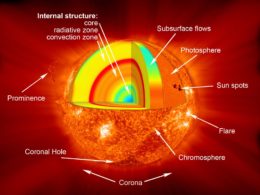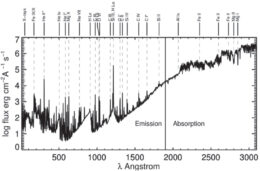Solar physicists have identified the best way to measure magnetic fields in the solar atmosphere, opening the door to deciphering the mysteries of a poorly understood part of the Sun.

An illustration of the regions of the Sun’s atmosphere and interior. Click to enlarge. [NASA/Goddard]
Our Multilayered Star
The Sun’s atmosphere has three layers: the photosphere, the chromosphere and the corona. The photosphere is the Sun’s visible surface and the corona is the wispy, tenuous outermost layer visible during solar eclipses. The chromosphere, a name that means sphere of colour, is sandwiched between the two and is incredibly thin. It takes up just one per cent of the Sun’s radius and yet understanding it is important work.
Strong magnetic fields corral hot plasma in the chromosphere into a network of super-sized granulation cells that can stretch to 20,000 miles across — some 2.5 Earth diameters — and 1,000 miles deep. On the edges of the cells sit spicules: spikes of magnetically confined plasma that shoot up into the corona above. The release of magnetic energy is also linked to events such as solar flares and coronal mass ejections, which can cause issues for our electrical infrastructure on Earth. So solar physicists want to know how magnetic fields emerge from, heat, and accelerate chromospheric plasma.
Magnetic Field Measurement
One way to measure the magnetic fields in the chromosphere is to take advantage of the Zeeman effect. Strong magnetic fields split the lines observed in the Sun’s spectrum. Recently a team led by Philip Judge (National Center for Atmospheric Research, Colorado) did something no one had ever done before: assess the comparative merits of using all spectral lines from X-ray to infrared wavelengths to measure magnetic fields as high as possible in the solar atmosphere.

A sample solar spectrum with prominent spectral lines labeled. Click to enlarge. [Judge et al. 2022]
Future Prospects
The recent Chromosphere Lyman-Alpha Spectro-Polarimeter (CLASP-2) instrument launched aboard a sounding rocket demonstrated that measurements at these wavelengths can be made successfully. A modest space-borne telescope focussing on the same part of the spectrum could provide a way to untangle some of the biggest riddles about the Sun’s chromosphere and the violent eruptions associated with it.
Citation
“Optimal Spectral Lines for Measuring Chromospheric Magnetic Fields,” P. Judge et al 2022 ApJ 941 159. doi:10.3847/1538-4357/aca2a5

